Feedback-Linearization-Based Fuel-Cell Adaptive-Control Paradigm in a Microgrid Using a Wavelet-Entrenched NeuroFuzzy Framework
Abstract
1. Introduction
2. System Overview and Model Description
2.1. Mathematical Modeling of the SOFC
2.2. Electrolyzer
3. Adaptive Feedback-Linearization-Embedded Fully Recurrent NeuroFuzzy Laguerre Wavelet Control
3.1. Mathematical Modeling
3.2. Update Equations for the Parameters of the Antecedent Part
3.3. Update Equations for the Consequent Part
- The measurement system transmits the actual and and calculates , which is the plant output, y.
- FRNF-Lag-WI captures the nonlinear dynamics, , and of the SOFC system based on the measured signals of the power system. The parameters of FRNF-Lag-WI are instantaneously optimized through the gradient descent algorithm to minimize the identification error defined in (19), which is back-propagated to FRNF-Lag-WI to optimize the membership functions of the antecedent part and weights of the consequent part.
- In parallel operation, the online estimation produces the appropriate input, . The coefficient vector, , is optimized through the nLMS algorithm in order to minimize the tracking error of (11).
- FBL-FRNF-Lag-WC generates an appropriate control law, , based on the identified functions, and , as well as the optimized , as given in (17).
- The estimated and cancel the nonlinearities of the system model and generate .
- in the SOFC controls the molar flow of hydrogen, and hence forces the to track .
4. Results and Discussion
5. Conclusions
Author Contributions
Funding
Institutional Review Board Statement
Informed Consent Statement
Data Availability Statement
Conflicts of Interest
Abbreviations
| FBL-FRNF-Lag-WC | Adaptive feedback-linearization-embedded fully recurrent NeuroFuzzy |
| Laguerre Wavelet Control | |
| SOFC | Solid-oxide fuel cell |
| FC | Fuel cell |
| RES | Renewable energy source |
| ANN | Artificial neural network |
| FBL | Feedback linearization |
| MSE | Mean square error |
| PMD | Pakistan Meteorological Department |
| THD | Total harmonic distortion |
| IAE | Integral absolute error |
| ITAE | Integral time-weighted absolute error |
| ISE | Integral square error |
| ITSE | Integral time-weighted square error |
References
- Nam, H.; Kasada, R.; Konishi, S. Correction to: Economic Analysis Between Diesel and SOFC Electricity via Fusion-Biomass Hybrid Model. J. Fusion Energy 2020, 39, 297–298. [Google Scholar] [CrossRef]
- Al-Khori, K.; Bicer, Y.; KoAS, M. Integration of Solid Oxide Fuel Cells into oil and gas operations: Needs, opportunities, and challenges. J. Clean. Prod. 2020, 245, 118924. [Google Scholar] [CrossRef]
- Awais, M.; Khan, L.; Ahmad, S.; Mumtaz, S.; Badar, R. Nonlinear adaptive NeuroFuzzy feedback linearization based MPPT control schemes for photovoltaic system in microgrid. PLoS ONE 2020, 15, e0234992. [Google Scholar] [CrossRef] [PubMed]
- Mumtaz, S.; Khan, L.; Ahmed, S.; Bader, R. Indirect adaptive soft computing based wavelet-embedded control paradigms for WT/PV/SOFC in a grid/charging station connected hybrid power system. PLoS ONE 2017, 12, e0183750. [Google Scholar] [CrossRef] [PubMed]
- Sukumar, S.; Marsadek, M.; Ramasamy, A.; Mokhlis, H.; Mekhilef, S. A Fuzzy-Based PI Controller for Power Management of a Grid-Connected PV-SOFC Hybrid System. Energies 2017, 10, 1720. [Google Scholar] [CrossRef]
- Yu, S.; Fernando, T.; Iu, H.H.C. Dynamic Behavior Study and State Estimator Design for Solid Oxide Fuel Cells in Hybrid Power Systems. IEEE Trans. Power Syst. 2016, 31, 5190–5199. [Google Scholar] [CrossRef]
- Stambouli, A.; Traversa, E. Solid oxide fuel cells (SOFCs): A review of an environmentally clean and efficient source of energy. Renew. Sustain. Energy Rev. 2002, 6, 433–455. [Google Scholar] [CrossRef]
- Singhal, S. Advances in solid oxide fuel cell technology. Solid State Ion. 2000, 135, 305–313. [Google Scholar] [CrossRef]
- Basu, S.N.; Pandey, A. Solid Oxide Fuel Cells: Recent Scientific and Technological Advancements. JOM 2019, 71, 3780–3781. [Google Scholar] [CrossRef]
- Zakaria, Z.; Awang Mat, Z.; Abu Hassan, S.H.; Boon Kar, Y. A review of solid oxide fuel cell component fabrication methods toward lowering temperature. Int. J. Energy Res. 2020, 44, 594–611. [Google Scholar] [CrossRef]
- Jienkulsawad, P.; Skogestad, S.; Arpornwichanop, A. Control structure design of a solid oxide fuel cell and molten carbonate fuel cell integrated system: Bottom-up analysis. Energy Convers. Manag. 2020, 220, 113021. [Google Scholar] [CrossRef]
- Baldi, F.; Wang, L.; Pérez-Fortes, M.; Maréchal, F. A Cogeneration System Based on Solid Oxide and Proton Exchange Membrane Fuel Cells With Hybrid Storage for Off-Grid Applications. Front. Energy Res. 2019, 6, 139. [Google Scholar] [CrossRef]
- Mumtaz, S.; Khan, L. Adaptive control paradigm for photovoltaic and solid oxide fuel cell in a grid-integrated hybrid renewable energy system. PLoS ONE 2017, 12, e0173966. [Google Scholar] [CrossRef]
- Carré, M.; Brandenburger, R.; Friede, W.; Lapicque, F.; Limbeck, U.; da Silva, P. Feed-forward control of a solid oxide fuel cell system with anode offgas recycle. J. Power Sources 2015, 282, 498–510. [Google Scholar] [CrossRef]
- Li, Y.; Wu, Q.; Zhu, H. Hierarchical Load Tracking Control of a Grid-Connected Solid Oxide Fuel Cell for Maximum Electrical Efficiency Operation. Energies 2015, 8, 1896–1916. [Google Scholar] [CrossRef]
- Devi, P.S.; Sharma, A.D.; Maiti, H.S. Solid Oxide Fuel Cell Materials: A Review. Trans. Indian Ceram. Soc. 2004, 63, 75–98. [Google Scholar] [CrossRef]
- Liu, Y.H.; Brandon, N.P.; Liu, M. Electrical Models of SOFC for Power Generation. In Proceedings of the 2012 Asia-Pacific Power and Energy Engineering Conference, Shanghai, China, 27–29 March 2012; pp. 1–4. [Google Scholar] [CrossRef]
- Awais, M. ES-5700 Energy Server; Bloom Energy Corporation: Sunnyvale, CA, USA, 2012. [Google Scholar]
- Dwivedi, S. Solid oxide fuel cell: Materials for anode, cathode and electrolyte. Int. J. Hydrogen Energy 2020, 45, 23988–24013. [Google Scholar] [CrossRef]
- IEEE Standard for Interconnection and Interoperability of Distributed Energy Resources with Associated Electric Power Systems Interfaces; IEEE Std 1547-2018 (Revision of IEEE Std 1547-2003); IEEE: New York, NY, USA, 2018; pp. 1–138. [CrossRef]
- Zafran, M.; Khan, L.; Khan, Q.; Ullah, S.; Sami, I.; Ro, J.S. Finite-Time Fast Dynamic Terminal Sliding Mode Maximum Power Point Tracking Control Paradigm for Permanent Magnet Synchronous Generator-Based Wind Energy Conversion System. Appl. Sci. 2020, 10, 6361. [Google Scholar] [CrossRef]
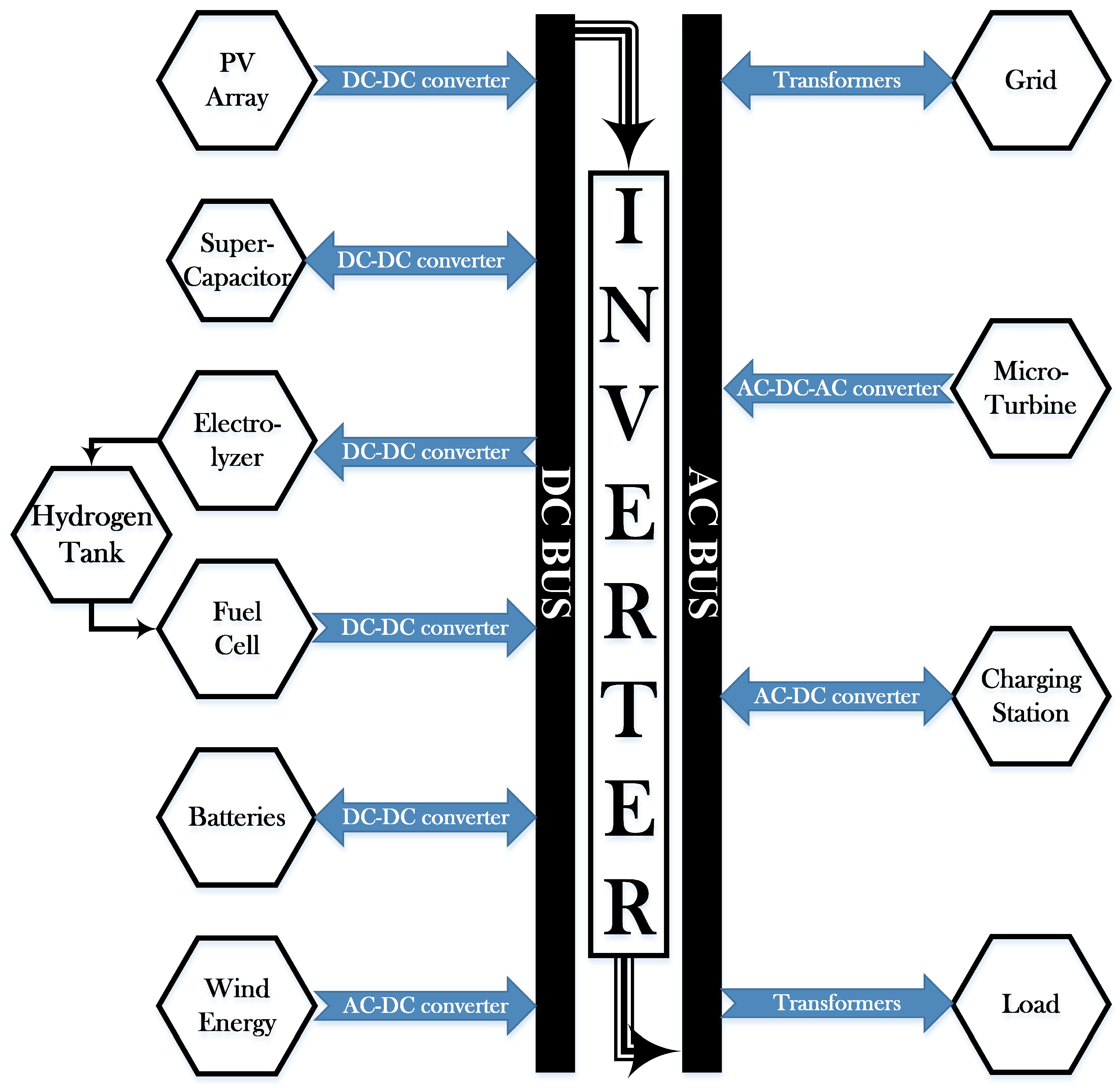
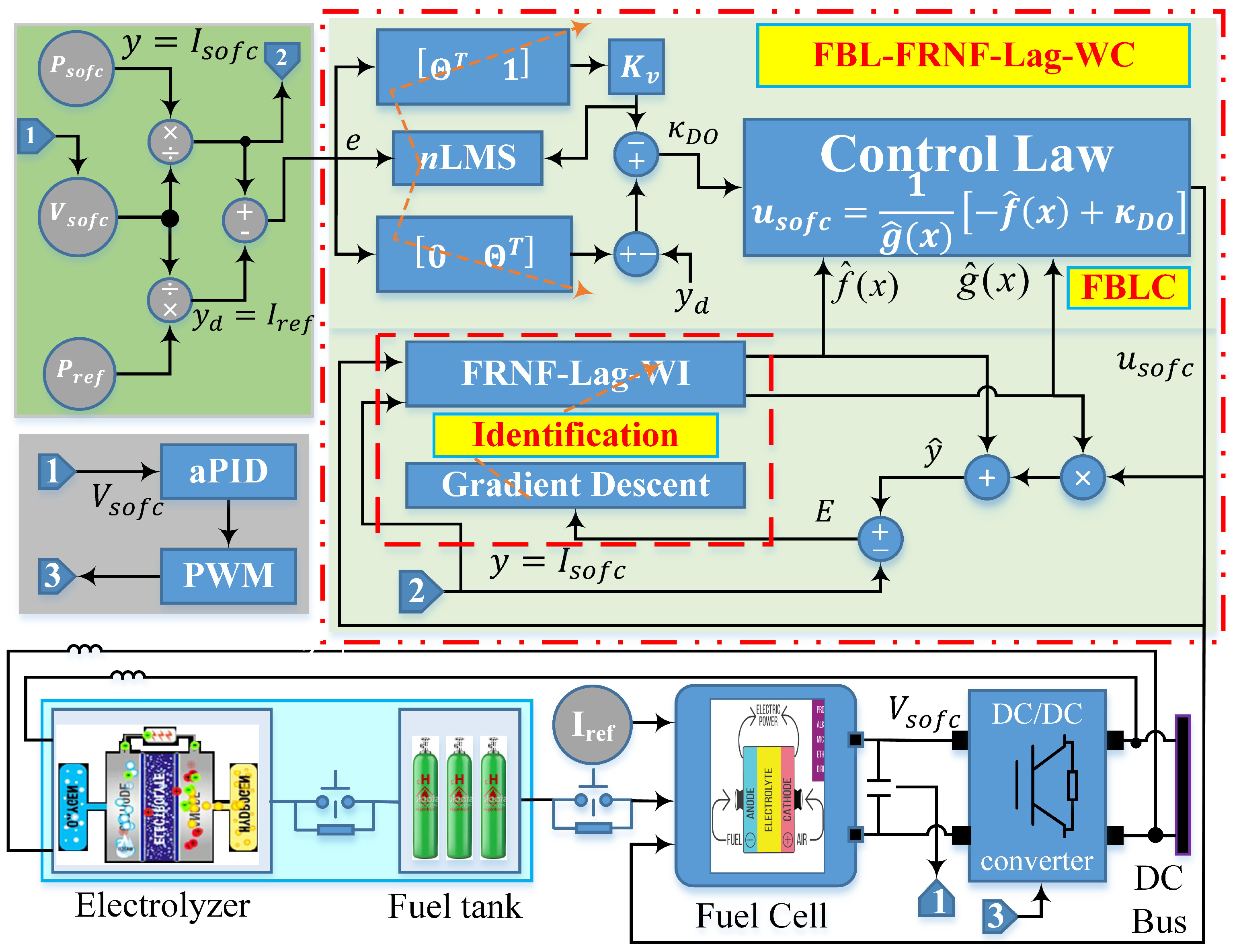
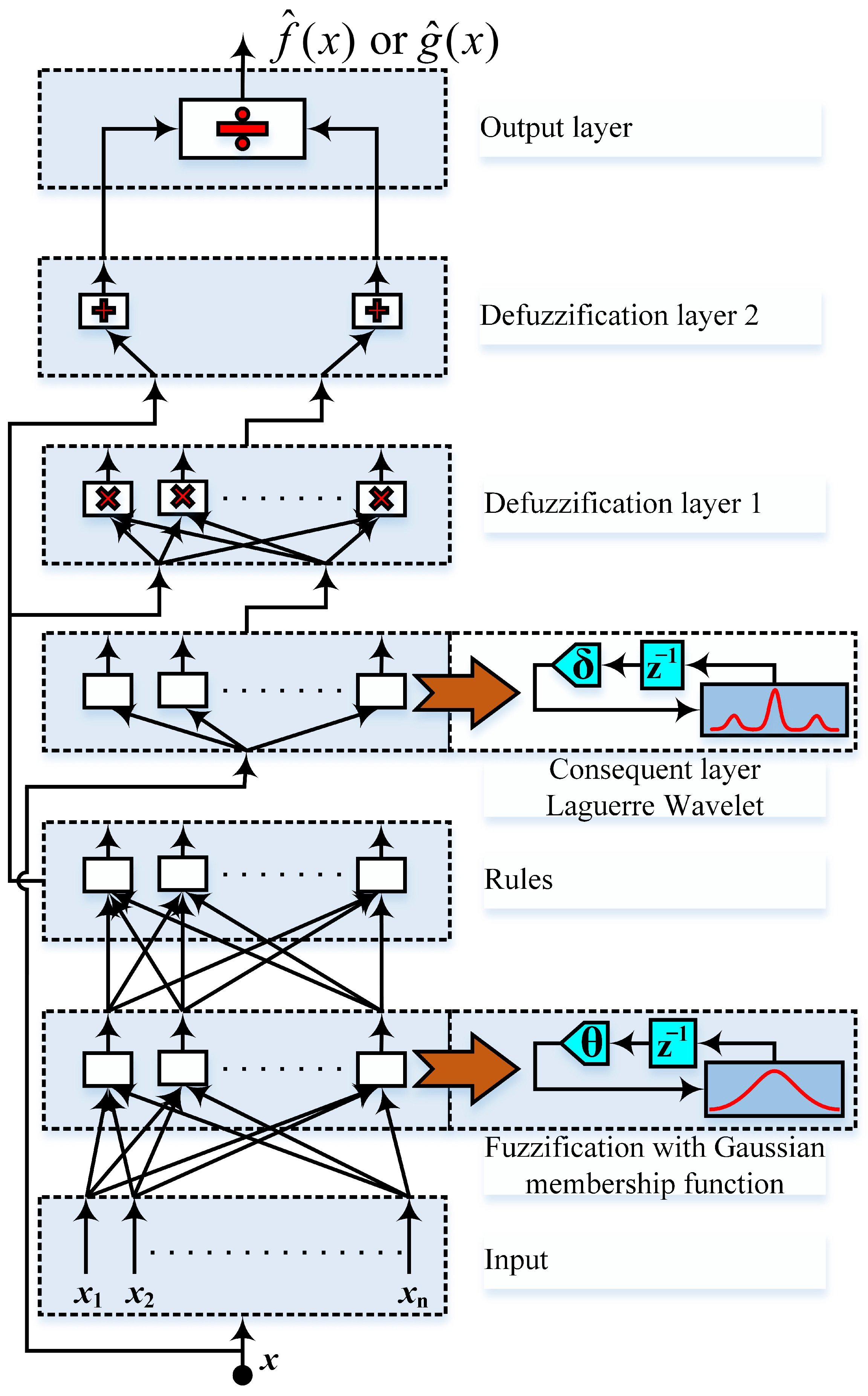
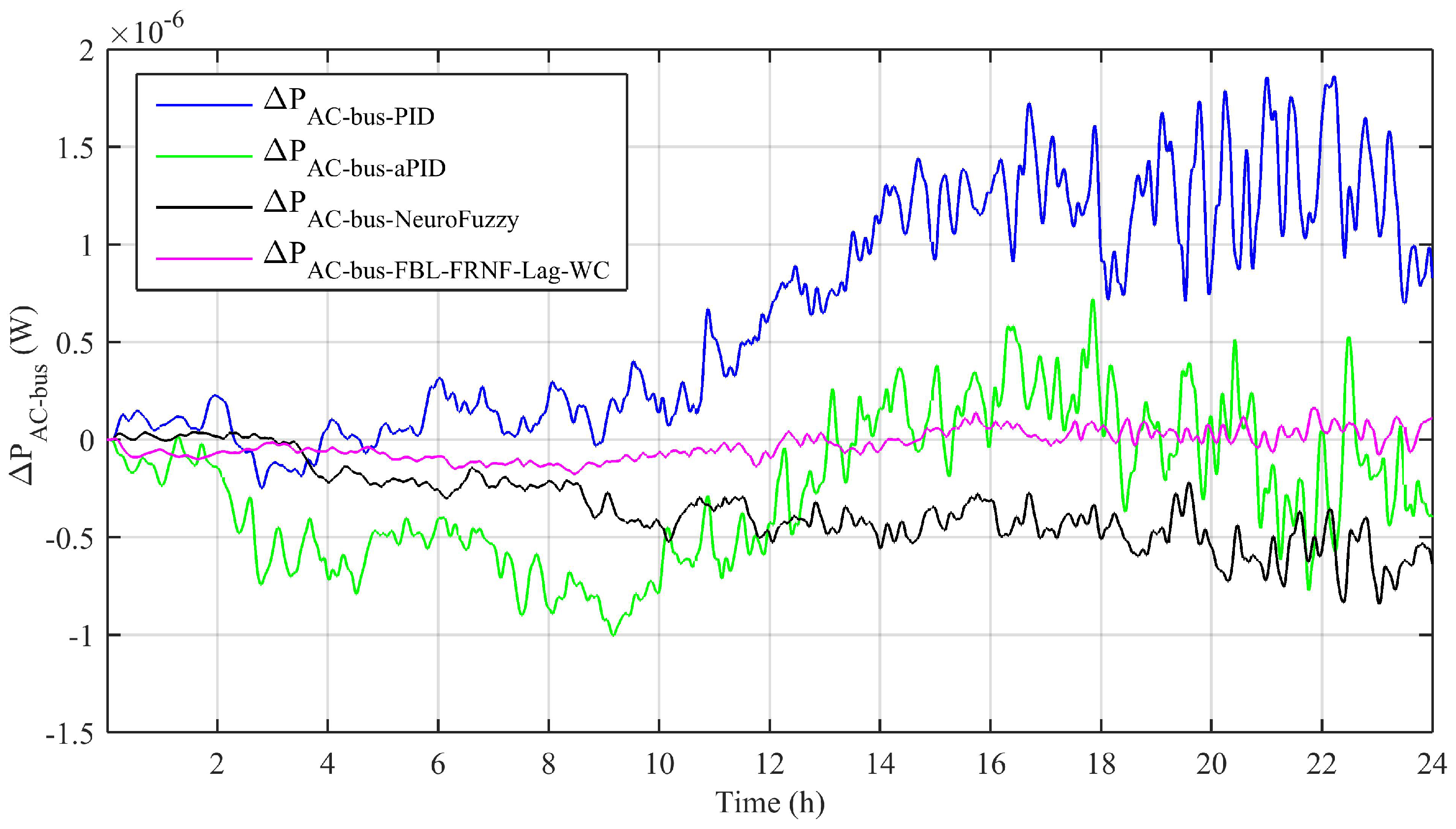




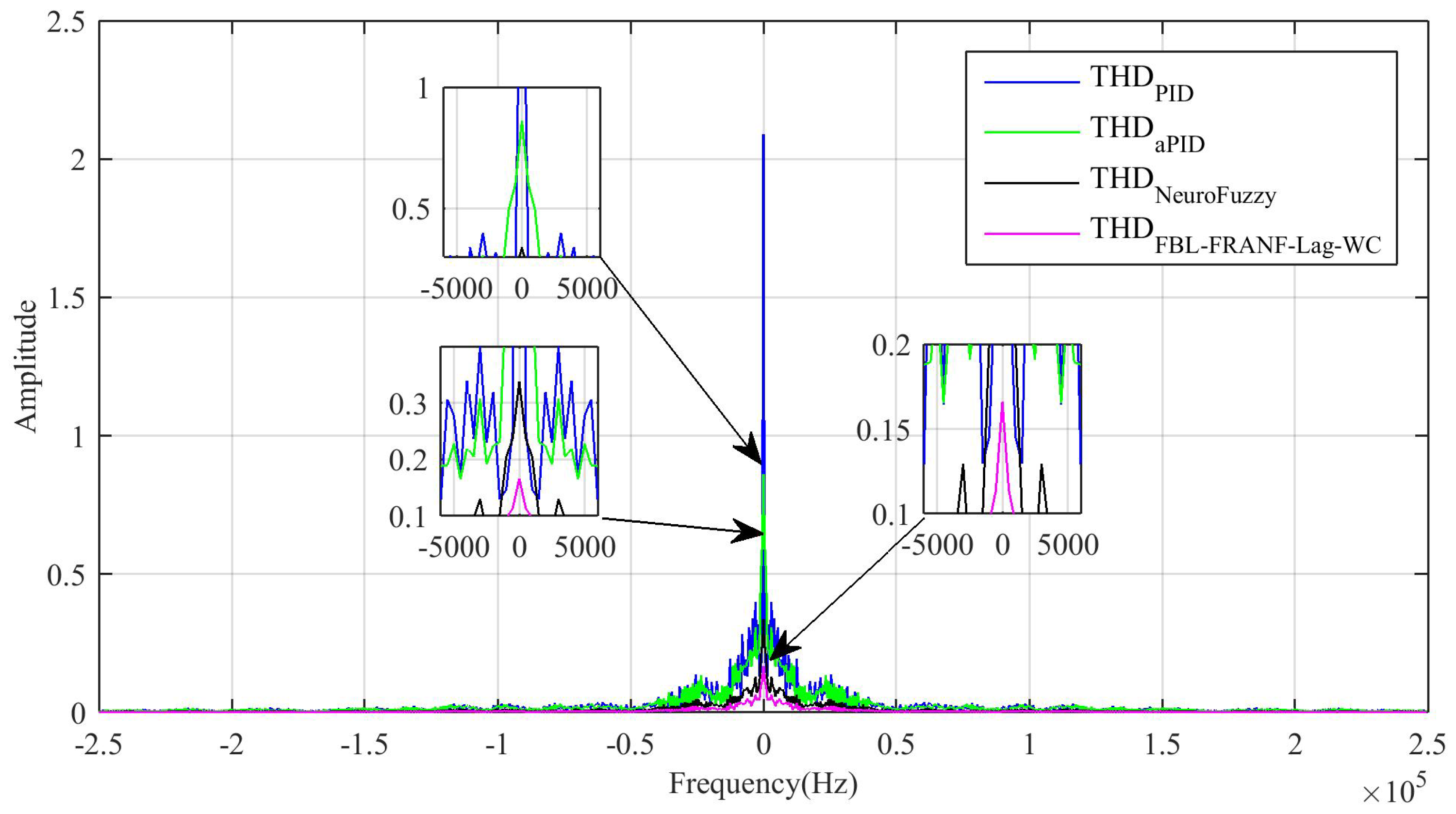

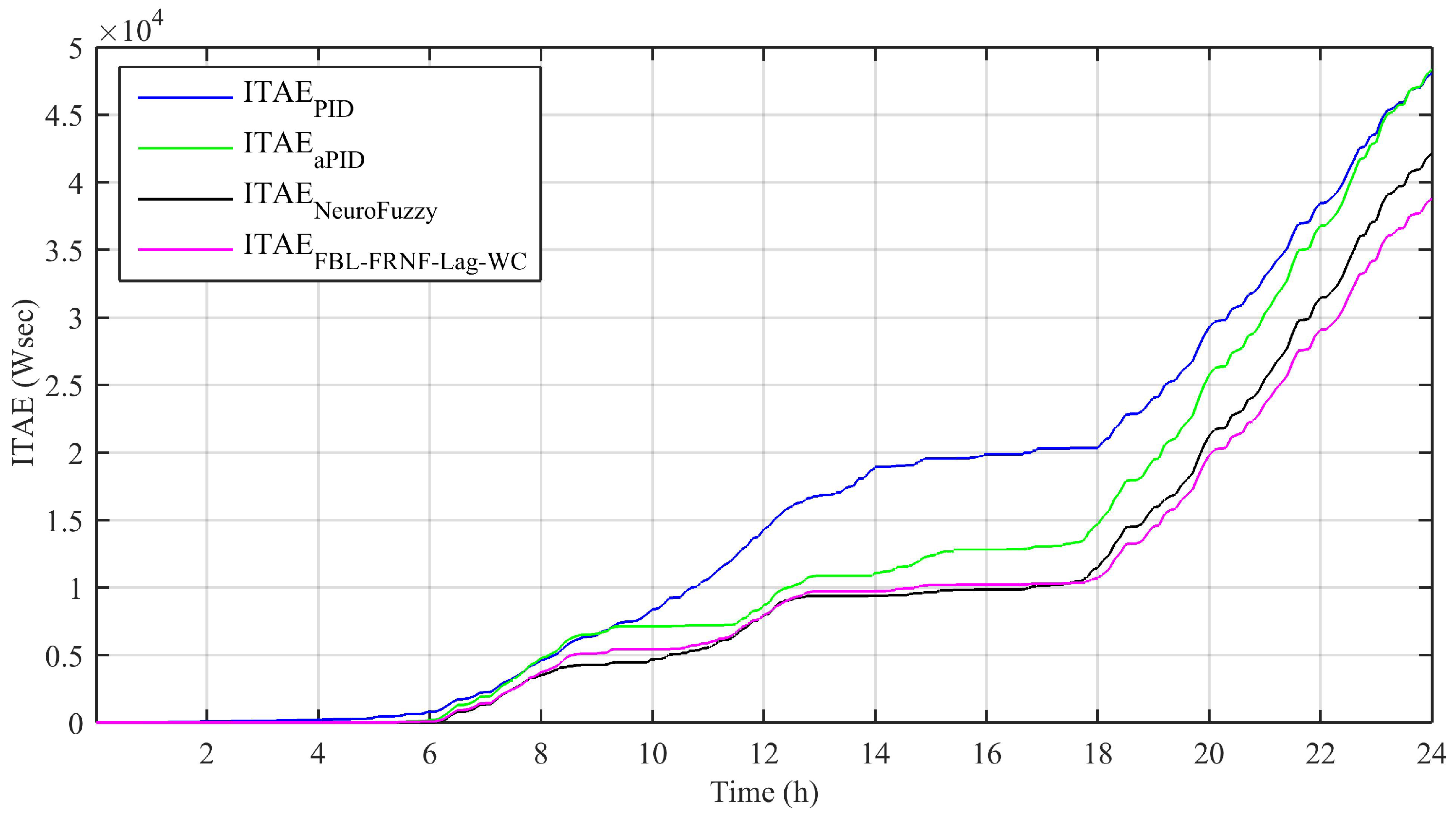
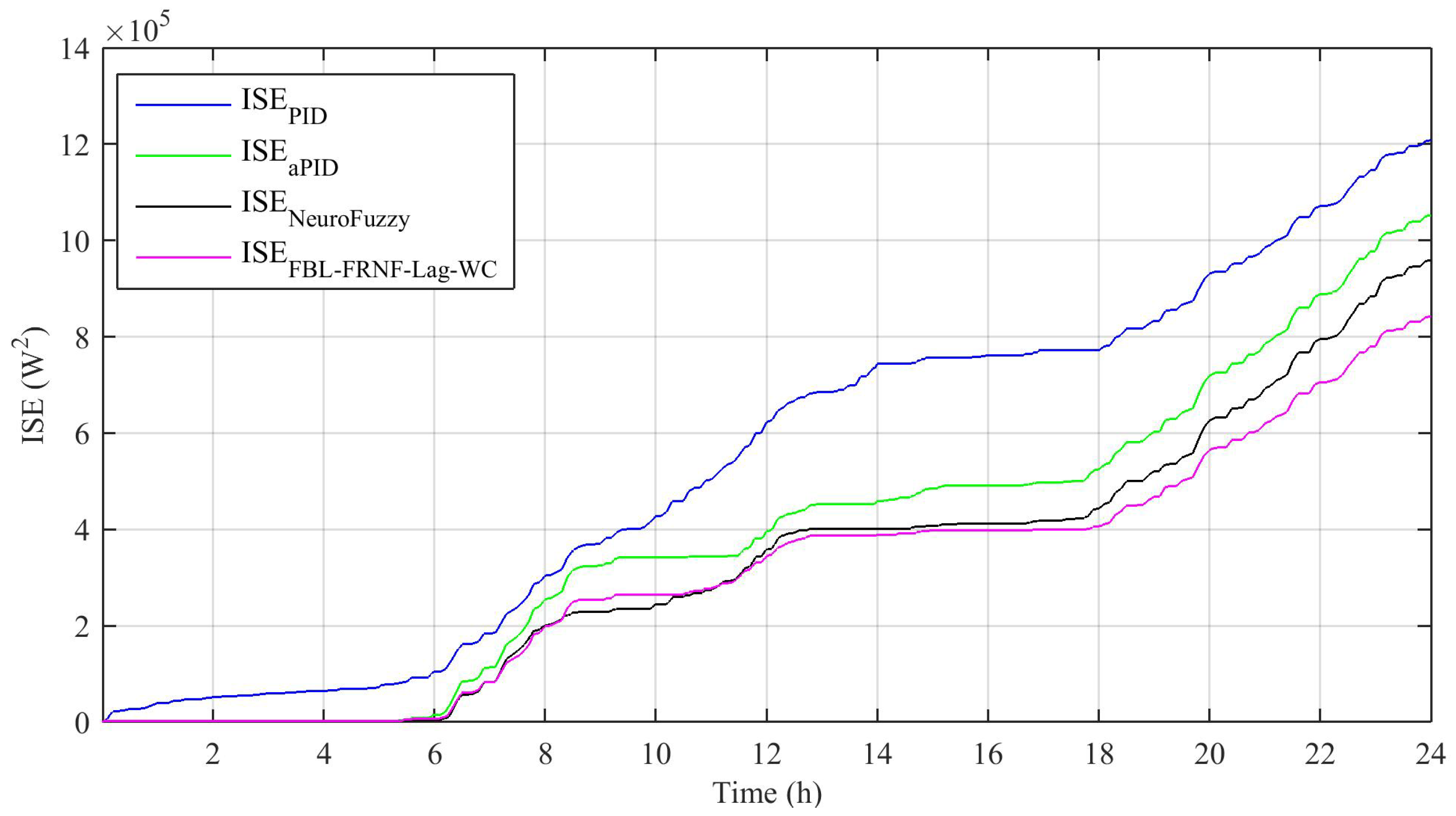
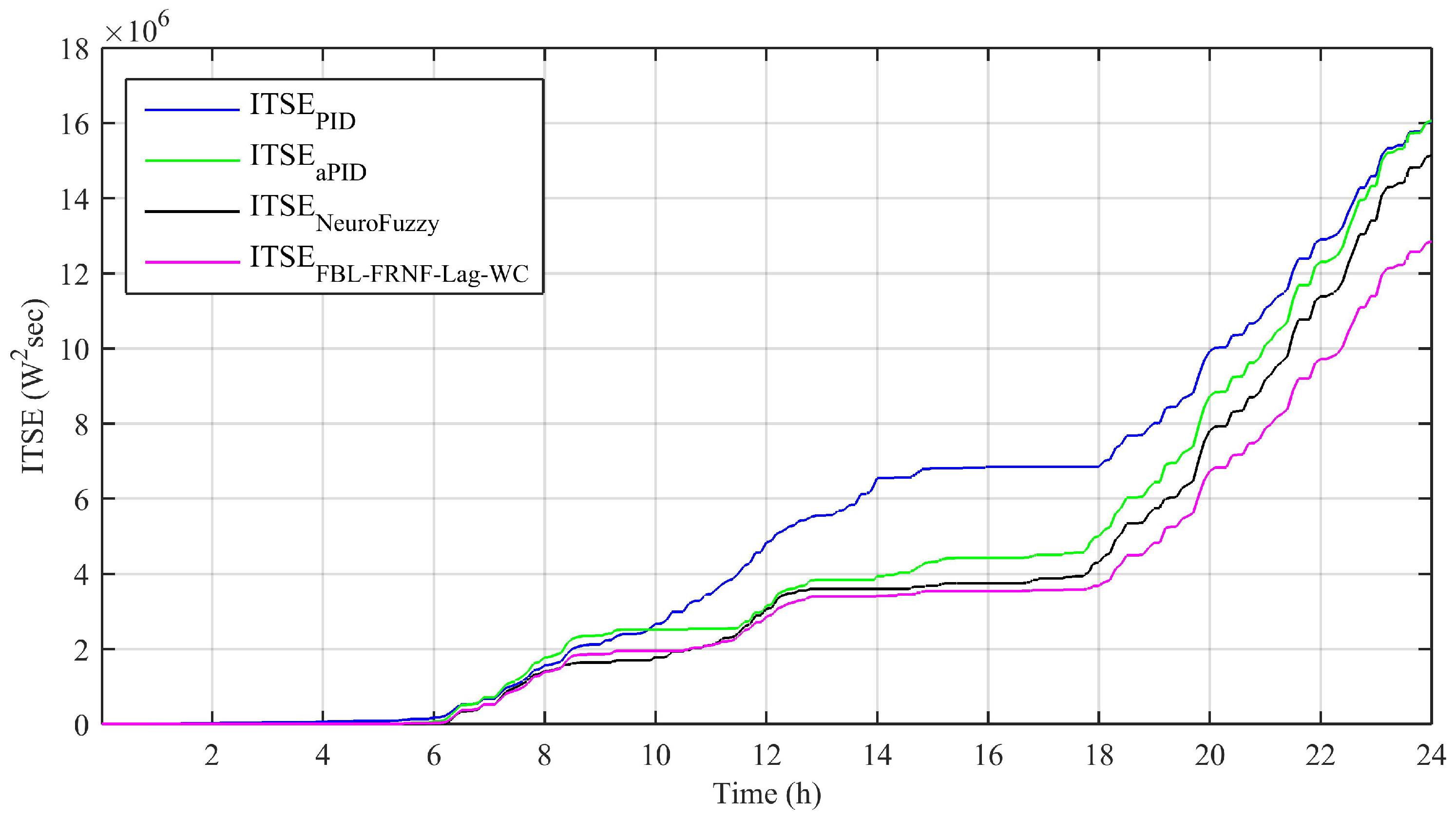
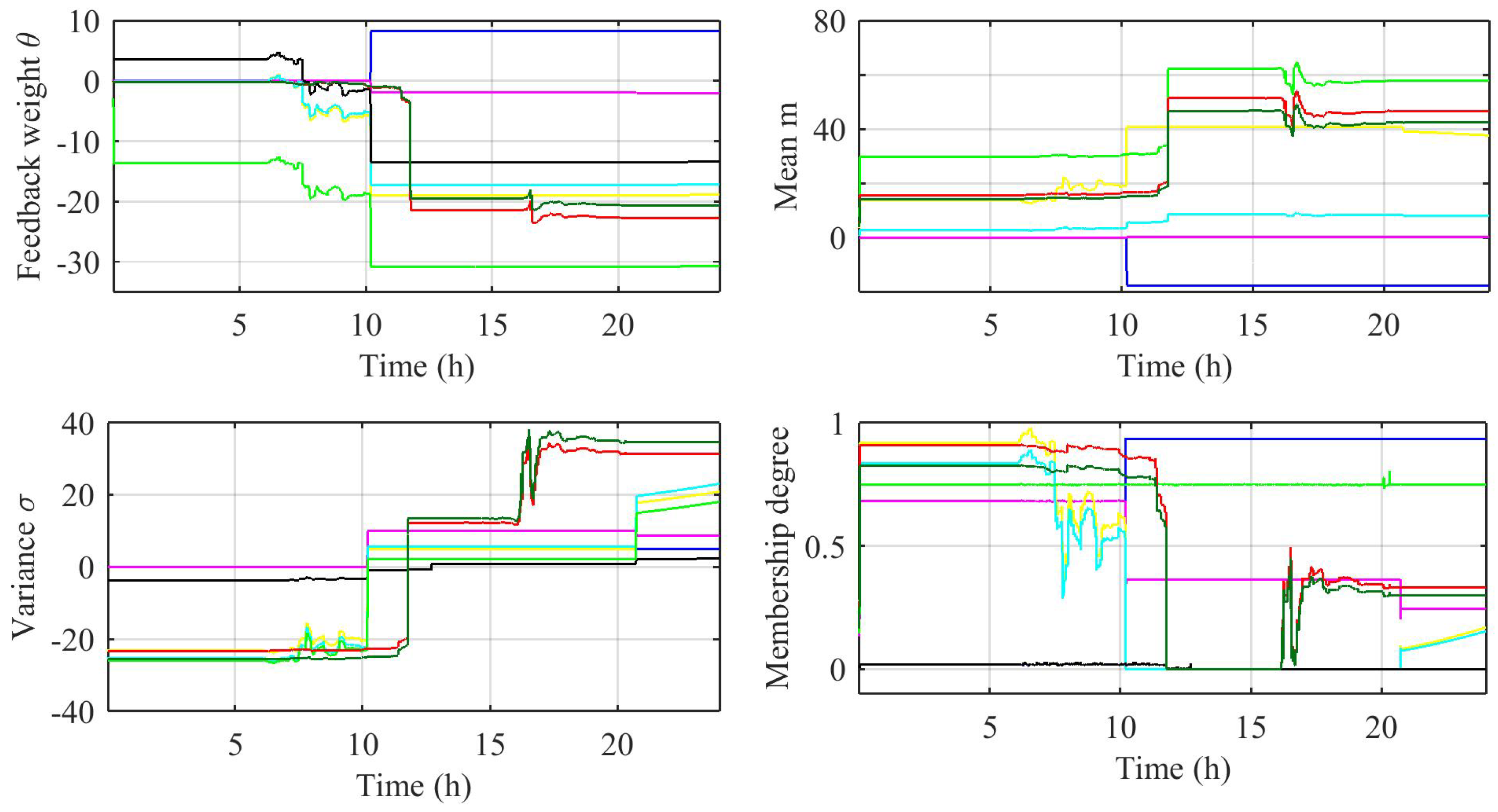
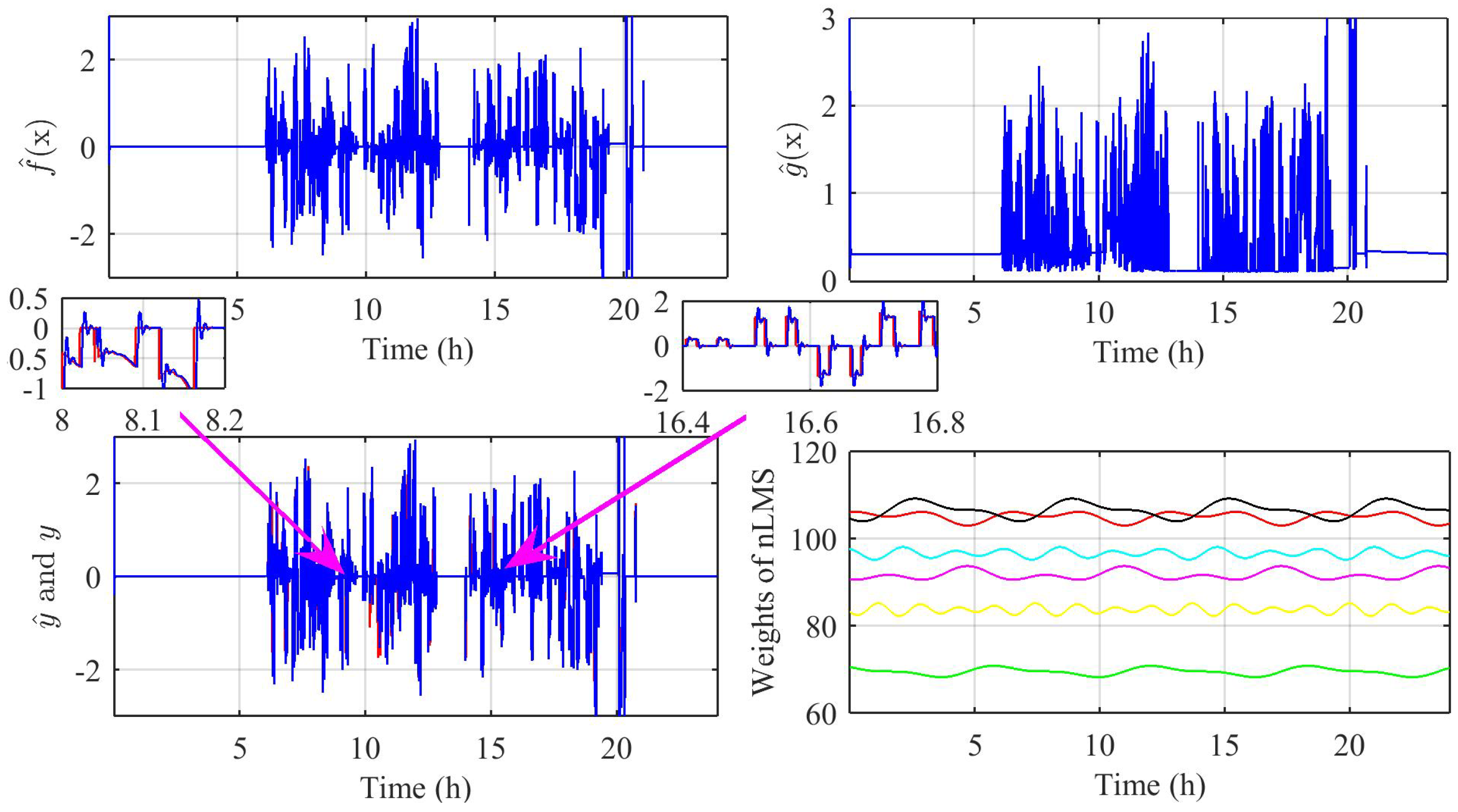
Publisher’s Note: MDPI stays neutral with regard to jurisdictional claims in published maps and institutional affiliations. |
© 2021 by the authors. Licensee MDPI, Basel, Switzerland. This article is an open access article distributed under the terms and conditions of the Creative Commons Attribution (CC BY) license (http://creativecommons.org/licenses/by/4.0/).
Share and Cite
Awais, M.; Khan, L.; Ahmad, S.; Jamil, M. Feedback-Linearization-Based Fuel-Cell Adaptive-Control Paradigm in a Microgrid Using a Wavelet-Entrenched NeuroFuzzy Framework. Energies 2021, 14, 1850. https://doi.org/10.3390/en14071850
Awais M, Khan L, Ahmad S, Jamil M. Feedback-Linearization-Based Fuel-Cell Adaptive-Control Paradigm in a Microgrid Using a Wavelet-Entrenched NeuroFuzzy Framework. Energies. 2021; 14(7):1850. https://doi.org/10.3390/en14071850
Chicago/Turabian StyleAwais, Muhammad, Laiq Khan, Saghir Ahmad, and Mohsin Jamil. 2021. "Feedback-Linearization-Based Fuel-Cell Adaptive-Control Paradigm in a Microgrid Using a Wavelet-Entrenched NeuroFuzzy Framework" Energies 14, no. 7: 1850. https://doi.org/10.3390/en14071850
APA StyleAwais, M., Khan, L., Ahmad, S., & Jamil, M. (2021). Feedback-Linearization-Based Fuel-Cell Adaptive-Control Paradigm in a Microgrid Using a Wavelet-Entrenched NeuroFuzzy Framework. Energies, 14(7), 1850. https://doi.org/10.3390/en14071850








